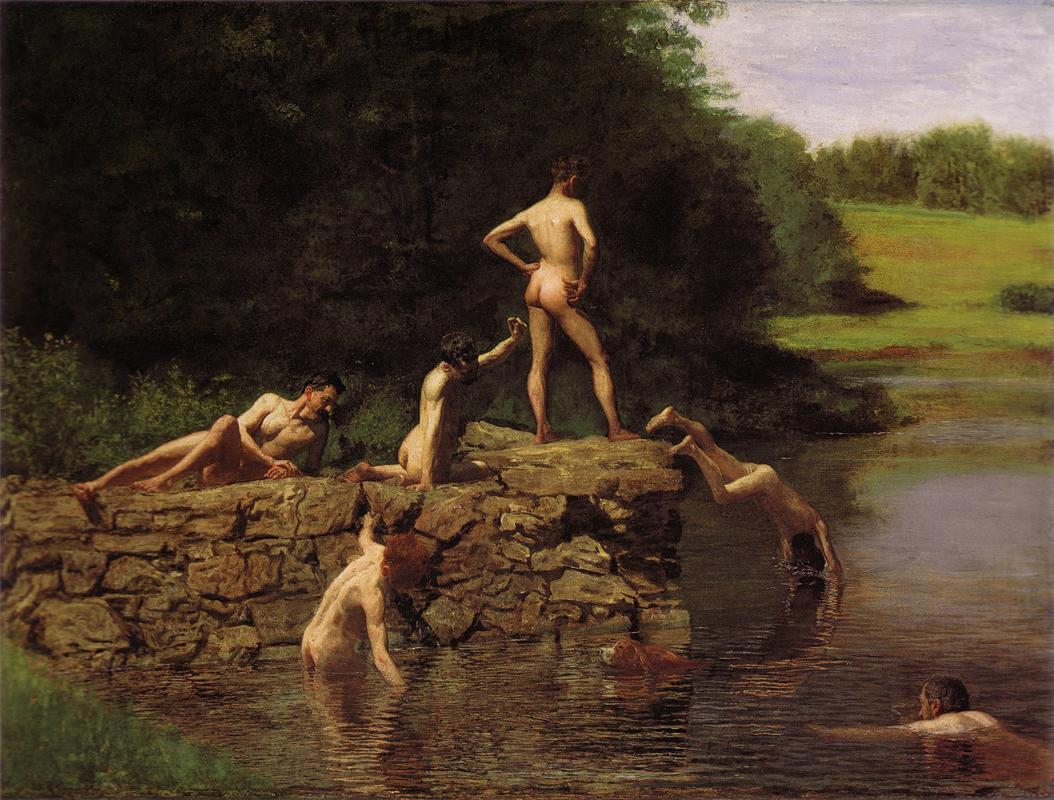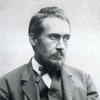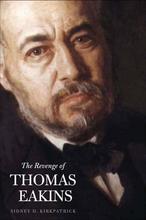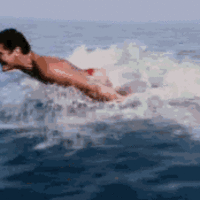More about Swimming
- All
- Info
- Shop

Contributor
In a wholesome portrait of 19th century Americana, Thomas Eakins shows us what has been termed “a scene of healthy, manly, outdoor activity”.
Yep, nothing hetero-sexier than a bunch of guys cavorting about in the nude! They’re not checking out each other’s butts at all. Critics say instead that each of the models is lost in his own “contemplative moment”. Well, there are contemplative moments and then there’s just basic butt gazing. Which I suppose is a contemplative effort in itself. From the reclining dude on the left all the way to the guy jumping into the water, every man is getting his own moment of Zen. Hats off to sly Eakins for this ingenious use of eye movement within the image!
Eakins’ boys in the buff were commissioned by a Philadelphia businessman. He offered $800 at the time for it, but for reasons unknown Mr. Coates didn’t purchase the picture after all. Maybe it was the not so subtle homoerotic undertones that critics love to ignore for some reason. We're guessing a fear of the "he who smelt it, dealt it" accusation, but for being gay. Eakins and his students played dumb, too.
Ironically, it’s the “innocent” nature of the frolicking fellows that makes the picture even hotter! Eakins was even so bold as to place himself at the bottom right of the painting in place of his own signature, which both furthers the naughty porn vibe and raises ethical questions about student-teacher skinny dipping in the 1880s. As a teacher myself, I can tell you that nowadays, it’s not exactly encouraged.
Aside from being “unintentionally” homoerotic, the figure are also a bit too posed. All the models seem to be arranged in very deliberate and planned stances, almost as if Eakins enjoyed closely studying each and every cheek. Despite the stiffness (pardon the pun), this painting received a lot of attention for being the first ever work of good old-fashioned American homoerotic art. [Inexplicit] Gay pride!
Featured Content
Here is what Wikipedia says about The Swimming Hole
The Swimming Hole (also known as Swimming and The Old Swimming Hole) is an 1884–85 painting by the American artist Thomas Eakins (1844–1916), Goodrich catalog #190, in the collection of the Amon Carter Museum of American Art in Fort Worth, Texas. Executed in oil on canvas, it depicts six men swimming naked in a lake, and is considered a masterpiece of American painting. According to art historian Doreen Bolger it is "perhaps Eakins' most accomplished rendition of the nude figure", and has been called "the most finely designed of all his outdoor pictures". Since the Renaissance, the human body has been considered both the basis of artists' training and the most challenging subject to depict in art, and the nude was the centerpiece of Eakins' teaching program at the Pennsylvania Academy of the Fine Arts. For Eakins, this picture was an opportunity to display his mastery of the human form.
In this work, Eakins took advantage of an exception to the generally prudish Victorian attitude to nudity: swimming naked was widely accepted, and for males was seen as normal, even in public spaces. Eakins was the first American artist to portray one of the few occasions in 19th-century life when nudity was on display. The Swimming Hole develops themes raised in his earlier work, in particular his treatment of buttocks and his ambiguous treatment of the human form; in some cases it is uncertain as to whether the forms portrayed are male or female. Such themes had earlier been examined in his The Gross Clinic (1875) and William Rush (1877), and would continue to be explored in his paintings of boxers (Taking the Count, Salutat, and Between Rounds) and wrestlers (Wrestlers).
Although the theme of male bathers was familiar in Western art, having been explored by artists from Michelangelo to Daumier, Eakins' treatment was novel in American art at the time. The Swimming Hole has been "widely cited as a prime example of homoeroticism in American art". In 2008, the art critic Tom Lubbock described Eakins' work as:
a classic of American painting. It shows a scene of healthy, manly, outdoor activity: a group of young fellows having stripped off for a dip. It is based on the swimming excursions that were enjoyed by the artist and his students. Eakins himself appears in the water at bottom right—in signature position, so to speak."
Check out the full Wikipedia article about The Swimming Hole














